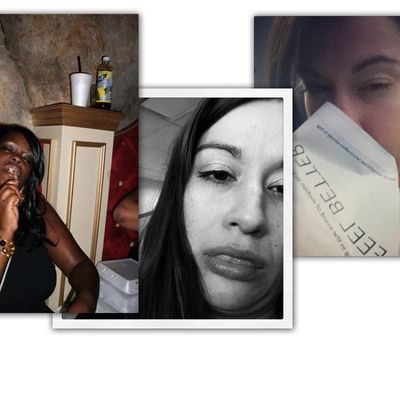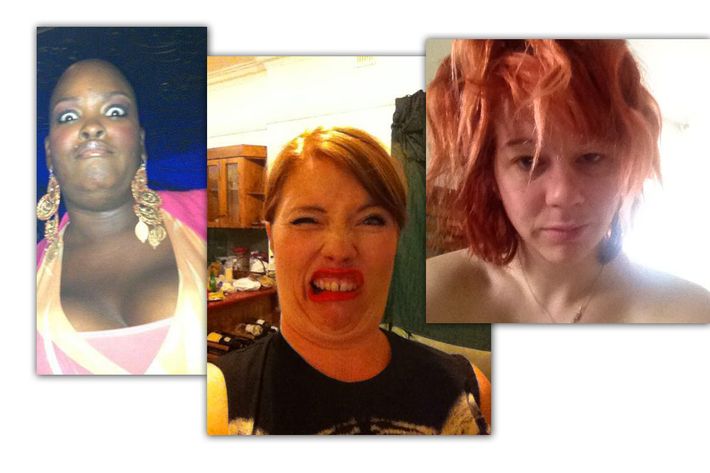
One Monday two years ago, Bay Area poet Sonya Renee Taylor did something many people wouldn’t: She picked a photo of herself that she hated, and made it her Facebook profile picture. Taylor already had her hundreds of well-curated images on the Internet. And, before this move, she had been regularly combing her Facebook profile for unflattering images and untagging them.
But Taylor had also just launched a “positive body image community” called The Body Is Not an Apology, and had grown wary of the ways in which she upheld the same beauty standards that her new website was railing against. “I had this secret cyber world full of images of myself that I hated,” she recalls. “I realized the reason that I was so intent on making them disappear was because I had this idea that I should only be seen if I looked a certain way.”
So Taylor took one of those images — the kind she would normally swiftly delete — and put it in Facebook’s marquee spot. She did the same thing the following Monday, and the Monday after that, christening the project “Bad Picture Monday” and encouraging others to follow her lead. Two years later, her once fledgling community has more than 16,000 fans on the social network. Indeed, at a time when impossibly glossy, carefully constructed images — not just of models and celebrities, but of lifestyle bloggers, Instagram stars, and old acquaintances you now only see online — invade our lives daily, “ugly photos” like hers are having a moment.

Part of their appeal stems from humor — think Reddit’s Pretty Girls, Ugly Faces meme, and its spinoff Handsome Guys, Ugly Faces, in which users upload photos of themselves pulling their most disgusting faces, posting them alongside more conventionally attractive shots. It’s the same idea as the Man Repeller, whose unique brand of “ugly chic” has made creator Leandra Medine one of the most influential fashion bloggers on the web. But as Taylor’s movement-of-sorts suggests, there is something more subversive to doing it yourself; as xoJane.com explains, “It sort of deconstructs our obsessive relationship with showing only our perfect selves.”
The “ugly selfie” wasn’t born on Reddit or on Bad Picture Monday, although both have become catalysts for it. It has spread quietly over a period of years, showing up in as many forms as there are facial expressions. For some, it’s a matter of pulling the strangest or least symmetrical grimace possible, while for others, it’s about capturing the least glamorous parts of everyday life. Some use hashtags like #uglyselfie, #prettygirlsuglyfaces or #nofilter to draw attention to what they are doing. Others discreetly insert their “uglies” amongst more typically aspirational social media content, waiting to see who discovers them. Sometimes it’s not even about taking a selfie at all, but about curtailing the temptation to curate, and letting your “bad” pictures sit alongside your good ones, as Taylor does.
New York comedian Katrin Hier was an early adopter of the trend, uploading her first “ugly selfie” three years ago, first to Facebook and later to Twitter. Like Taylor, Hier was inspired by her own social media feeds, which she says were increasingly “plastered with these very narcissistic ‘hot’ pictures … almost as if [people were] scrutinizing their faces for perfection.” Instead, Hier began posting pictures of herself in the least sexy situations she could think of — lying in bed with food poisoning, watching TV on the coach, sitting in her cubicle at work — and labelling them with hashtags such as #lookinglikedeath, #exhausted, and #nomakeup.
Hier’s photos are designed to make people laugh. “It’s satire,” she admits. But she also describes them as “a kind of revelling in the grotesque.” She explains, “There is a grit to being a girl that isn’t often acknowledged: We binge eat, we don’t sleep enough, we get bloated when we get our periods.” She points to Girls creator Lena Dunham and British author Caitlin Moran, both of whom play upon the more “gross-out” aspects of femininity in their work. Hier’s photos are also, she says, “a rejection of this idea that we have to be everything. Look good, succeed in a job, be a MILF … sometimes we’re too busy to look pristine.”
Australian feminist Clementine Ford was inspired to start posting “uglies” after a conversation with friends about her own social media habits. “Any photo I uploaded online was usually the best of 40 different options, so I sent them an ‘ugly’ version as a joke,” she says. They — and she — thought it was so much fun that she decided to do it regularly. In doing so, she’s realized that people mostly laugh at them or take her lead, rather than comment on her looking terrible.
For Ford, the ugly selfie serves as a cheeky offset to her own vanity. “Whenever I upload a photo that is deliberately constructed to make me look appealing in some way, my rule is that I have to also upload one taken of me looking monstrous or ridiculous,” she explains. “It puts personality back into a superficial practice of self-documentation that has become devoid of anything real.”
Speaking to women who have embraced the ugly selfie, these authenticity themes come up repeatedly. Emily Dam, 28, who uploads one to Twitter or Instagram each week using a hashtag like #badhairday, says it’s a reminder to be genuine. “Conventional selfies are too posed,” she says. “Why I would pretend to be made up when I’ve been to the gym and have sweat pouring down my face?”
It’s not that bad photos don’t happen in the wild anymore — most of us take plenty of them. But unless you are part of the tiny subset of the population who is trailed by paparazzi, few people actually see you at your photographic worst. More than ever, we have the technology to control the way we look to other people, and we use it. “Digital cameras have created a world in which everyone is beautiful,” Taylor argues. And ugly selfies, on the other hand, give permission to stop monitoring yourself for a moment.
But to what extent do they succeed? Pretty Girls, Ugly Selfies may provide a space for women to unleash their inner “ugly,” but the joke relies on there being a conventionally “pretty” picture to accompany it. Since most of us are neither Reddit ugly nor supermodel hot, these newer, sillier faces don’t actually require any real vulnerability: When you’re posing — even in a ugly way — there is little risk of anyone thinking that’s what you “really” look like. It’s visual hyperbole. Or, as ugly selfie aficionado Emma Froggatt, 22, puts it, “The ugliest photos are often the ones where you don’t mean to look ugly.”




